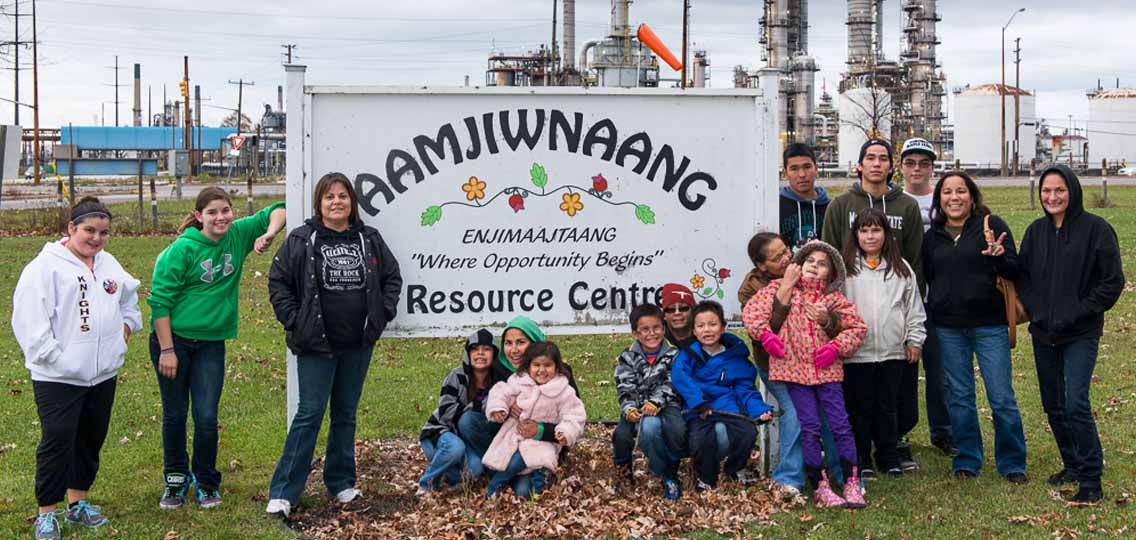A second air sample taken by the Aamjiwnaang Bucket Brigade contained some unpleasant results and further revelations about flaws in Canada’s pollution laws. The sample was taken on a ‘clean air’ day on the Aamjiwnaang First Nation Reserve, near Sarnia, Ontario. The volunteer Bucket Brigade had taken the “clean” sample to establish what chemicals are in the air on an average day.
Instead of clean air, the results of the independent test revealed levels of two hazardous sulfur compounds that exceed known health based thresholds. One of the chemicals is listed as a known developmental toxin that can interfere with the reproduction system.
“We were shocked and disappointed that even on a good day our air contains high levels of reproductive toxins,” said Vicki Ware of the Aamjiwnaang Environmental Committee who took the sample. “Once again the government has approved companies being permitted to operate without even basic protections for public health and safety.”
The sample was taken on March 10, 2008. A United States EPA certified laboratory in California analyzed the sample because Canada does not have independent facilities for testing toxic air samples. The lab results showed the following chemicals present:
- Carbon Disulphide at 41 micrograms per cubic meter
- Carbonyl Sulphide at 44 micrograms per cubic meter
- Octamethylcyclotetrasiloxane at 100 at micrograms per cubic meter
- Ethanol at 130 micrograms per cubic meter
- Isopropyl Alcohol at 11 micrograms per cubic meter
- d-Limonene at 6.4 micrograms per cubic meter
The chemical of greatest health concern in the sample is Carbon Disulphide, which is a known reproductive toxin and is listed as such by the State of California. The Aamjiwnaang First Nation has documented a troubling birth ratio problem among band members and received international attention due to high concentration of toxic industries that surround the reserve.
The level of Carbon Disulfide in the sample was 41 micrograms per cubic meter (ug/m3), which exceeds US health-based levels of between three and 30 (ug/m3) for short and long-term exposure. Ontario has a Point of Impingement level for odor of 330 ug/m3 that applies at the fenceline of a facility, but does not have a health-based standard for assessing human exposure.
Another chemical in the sample that exceeded US health-based standards was Carbonyl Sulfide. The Aamjiwnaang sample contained 44 ug/m3 of Carbonyl Sulfide, five to 50 times higher than the US standards. Neither Ontario nor Canada has any standards for this toxic gas. Carbonyl sulfide is a by-product of petroleum refining and destructive distillation of coal.
“Canada and the province of Ontario lack basic health based standards to protect the public from toxic pollution,” said Denny Larson, Executive Director of Global Community Monitor, whose organization trained the band members to take air samples. “This is why US and other non- Canadian companies are crossing the border to build and operate plants in order to avoid stronger regulation.”
“Our independent testing confirms we are being exposed to cumulative effects of multiple toxic chemicals in every breath we take,” said Ada Lockridge, Chair of the Aamjiwnaang Environmental Committee. Lockridge’s last air sample revealed several forms of cancer causing benzene in the air.
According to data self-reported by industry to the 2006 National Pollutant Resource Inventory (NPRI), potential sources of pollutants in the sample are:
- Carbon disulphide and carbon sulphide: Cabot Canada
- Isopropyl Alcohol: Shell Chemicals Corunna; UBE Automotive; Nova Chemicals Mooretown; Imperial Oil Sarnia Chemical Plant; Imperial Oil Sarnia Refinery; Shell Canada Sarnia Manufacturing Centre Corunna.
However, the province only requires facilities to report releases of these chemicals to the NPRI if they release more than 10 tonnes each year. Facilities that release less than the threshold amount do not have to report any of their releases.
“Given the exceptionally high density of industrial polluters in the area and high thresholds for reporting these types of chemicals, it is difficult to determine which facility released these particular toxic chemicals,” stated Ecojustice senior scientist and professional engineer, Dr. Elaine MacDonald. “This clearly highlights the need for better reporting of toxic releases from industry in Sarnia and across the country.”
Additional chemicals detected in the sample show Octamethylcyclotetrasiloxane, which is used in synthetic rubber manufacturing although it is not an NPRI reported chemical. Limonene is the major component of the oil extracted from citrus rind and is used as a solvent.

